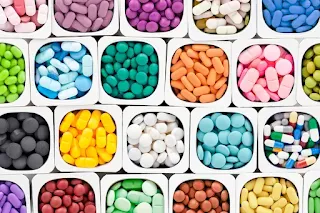Medical information: The eye eats before the mouth .. Does the color of the grain affect the effectiveness of healing?
Medical information: The eye eats before the mouth .. Does the color of the grain affect the effectiveness of healing?
Don't take your prescription with a glass of water the next time it's prescribed to you. Consider the hue of the pills for a moment. It's possible that your drug will work sooner and better than it has in the past.
Medicines' active chemicals are not present in the cause of therapy; however, everything about the medicine, including the brand name, marketing, and packaging, has an impact on how we feel after taking it.
And it's possible that the color of the pills has the greatest impact of all.
The color of the pills is not chosen at random.
Medicines in the form of pills have been around since ancient Egypt, but they didn't start appearing in color until the 1960s and 1970s. Before that, they were all white.
Colors were added to the tablets to make them more appealing for marketing purposes, to conceal the contents of the capsules, to shield internal medicine from the effects of sunlight, and to assist both makers and patients in distinguishing between different medicines.
While the major pharmaceutical companies that first introduced color to their pills may not have realized the entire impact of pill color on their consumers, they are now investing money in research to find the optimal colors for different treatments.
According to studies, altering the color of tablets has a notable negative effect on patients and increases the likelihood that they will quit taking the medication.
According to a 2013 study, the color of a prescription drug has an impact on whether or not a patient will cease taking it.
The color of the drug acts as a form of placebo, causing the so-called "placebo effect," which states that if you truly believe the tablet contains simply sugar and no actual component that can treat your headache, you will experience what you believe. The placebo effect is the name for this phenomenon.
The effectiveness of actual drugs is also influenced by placebos. Which would you select if you had two comparable ointments to alleviate itching, but one was red and the other was white?
The color blue is generally connected with sedatives and has a relaxing effect, whereas the colors orange and red are associated with stimulants.
This is why non-hypnotic cold and flu medicines are commonly packaged in a half-red capsule, signifying the drug's non-hypnotic action.
Because green is a calming color, oxycodone, which is used to treat chronic pain, is packaged in a little green pill.
Yellow is recognized to have anti-depressant effects, so it's no wonder that it's used in this way.
Valium is available as a little yellow tablet.
According to a 1970 study, the yellow pill is the most effective antidepressant.
According to a 1982 study, green drugs are more effective in reducing anxiety, while white medicines are more effective at relieving pain.
So, to get rid of the itch, you'd select white ointment over red ointment, right?
These impressions are enhanced with brighter colors and embossed brand labels.
White aspirin pills in packaging with the drug's name were more effective than unknown aspirin pills in containers without the drug's name in a 1981 trial.
The pill's hue has a physiological effect.
The retina's light-sensitive cells convey information to the brain, which creates visual representations of the world around us.
However, retinal ganglion cells respond to light by sending separate signals to a different area of the brain, the hypothalamus or hypothalamus, which is not involved in the creation of visual images.
The release of many hormones that affect various aspects of body functions, such as temperature, weariness, sensations of hunger, and circadian rhythms, is controlled by this portion of the brain.
While the exact workings of this system are unknown, it is obvious that color and light have an impact on our mood and alertness.
Is there a role for culture in our perceptions of colors?
A study in the United Kingdom found that people who were exposed to red light had a higher heart rate, whereas those who were exposed to blue light had a lower heart rate.
The suicide rate by jumping in front of trains was lowered when blue lights were introduced in subway stations in Tokyo, for example.
Blue tablets, on the other hand, are thought to be stimulating in Italy.
The researchers theorized that the cause was linked to the color of the Italian national football team, and consequently to the substance adrenaline secreted by the players' bodies during the game.
Because the whites of a person's eyes might turn yellow when they have malaria, the yellow color is connected with antimalarial medications in Africa.
Surprisingly, this viewpoint differs from the norm. Medications, like scalded skin, operate best when their hue corresponds to the desired result rather than the symptoms of the ailment they're treating.
Because of these cultural differences, medicine appears differently in different countries, forcing pharmaceutical corporations to provide their drugs in varied hues depending on the target country.








أضف تعليق